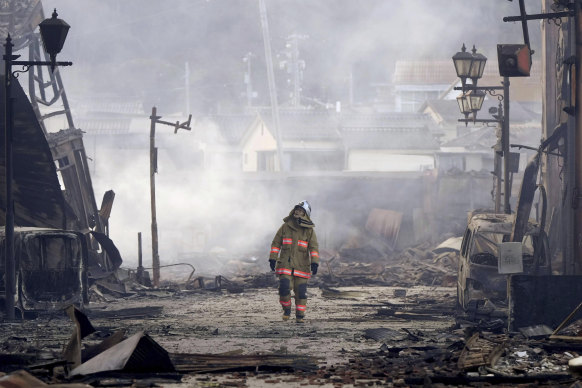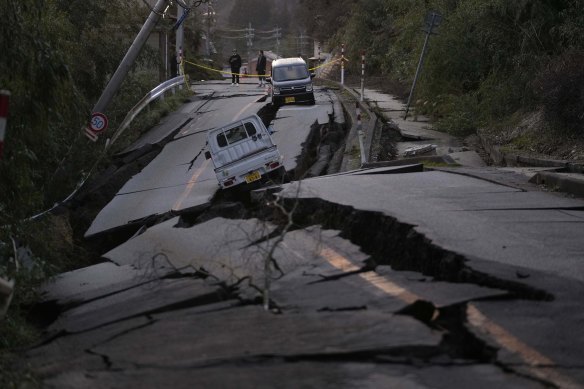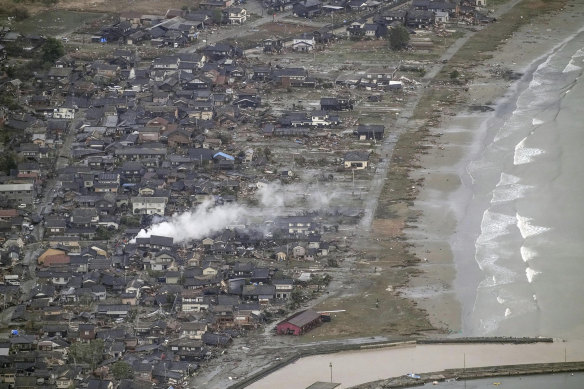- Updated
- World
- Asia
- Earthquakes
This was published 1 year ago
Japan quake toll rises as many trapped under possibly thousands of homes
By Kiyoshi Takenaka and Sakura Murakami
Kashimaji, Japan: The death toll from a massive earthquake that struck Japan on New Year’s Day has risen as authorities rushed to bring aid to survivors facing freezing temperatures and expected heavy rain.
In Suzu, a town of a little more than 5000 households near the quake’s epicentre, 90 per cent of houses may have been destroyed, according to its mayor Masuhiro Izumiya.

A firefighter looks up the rubble and wreckage of a burnt-out marketplace following an earthquake in Wajima.Credit: Kyodo News via AP
“The situation is catastrophic,” he said. The quake with a preliminary magnitude 7.6 struck on Monday, levelling houses and cutting off remote areas from much-needed aid.
Heavy rains were forecast in the quake-hit areas raising fears of landslides, authorities said, in what could further hinder efforts to free many more trapped under rubble.
The number of reported fatalities reached 64, although the full extent of the damage remains unclear, according to a report from Kyodo news agency, up from 55 late on Tuesday, making the earthquake the deadliest in the country since at least 2016.
“It’s been over 40 hours since the initial quake. This is a battle against time, and I believe now is a crucial moment in that battle,” Japanese Prime Minister Fumio Kishida said at a news conference held after a disaster response meeting on Wednesday.
“Now is a critical moment,” he said. “We are doing everything to save lives.”
The government opened a sea route to deliver aid and some larger trucks could reach some of the hardest-hit areas and the accident at Tokyo’s Haneda airport on Tuesday involving a coast guard plane working on relief efforts wasn’t having a logistical impact on rescue operations, Kishida said.
Mitsuru Kida, 74, a survivor of the earthquake who lives in hard-hit Wajima city, feared for a return to life as usual given the damaged insfrastructure.
“The road conditions are terrible. This is the first time the roads have been damaged this badly,” he said at a makeshift evacuation centre.

Bystanders inspect the damage near Noto on Tuesday.Credit: AP
“I have an impression that most people have yet to regain energy to stand up again at the moment.”
Smaller quakes continue to hit the Noto Peninsula. Firefighters searching for survivors in the rubble of a partially collapsed building were seen rushing out to safety as an earthquake warning alarm sounded before noon on Wednesday, according to footage broadcast by public broadcaster NHK.
About 200 tremors have been detected since the quake first hit, according to the Japan Meteorological Agency, which warned that more strong shocks could hit in coming days.
“The government has deployed emergency rescue teams from the Self-Defence Forces, police and fire departments to the area and is doing its utmost to save lives and rescue victims and survivors, but we have received reports that there are still many people waiting to be rescued under collapsed buildings,” the prime minister said.
Kishida said some 3000 rescuers were finding it difficult to reach the northern tip of the peninsula where helicopter surveys had discovered many fires and widespread damage to buildings and infrastructure.
Japan sits on the “Ring of Fire” arc of volcanoes and oceanic trenches that partly encircles the Pacific Basin. It accounts for about 20 per cent of the world’s earthquakes of magnitude 6 or greater, and each year experiences up to 2000 quakes that can be felt.
Many rail services and flights into the quake area have been suspended. More than 500 people were stranded at Noto’s airport, which closed due to cracks in its runway and access road and damage to its terminal building.
Many of the deaths were in Suzu and Wajima, another city on the remote northern tip of the Noto peninsula. Scores more have been injured.
“I’ve never experienced a quake that powerful,” said Wajima resident Shoichi Kobayashi, 71, who was at home having a celebratory New Year’s meal with his wife and son when the quake struck, sending furniture flying across the dining room.
Fujiko Ueno, a 73-year-old resident of Nanao city in Ishikawa, said nearly 20 people were in her house for a New Year celebration when the quake struck and splintered the walls, which came crashing down on a parked car. Miraculously, no one was hurt.
“It all happened in the blink of an eye,” she said, standing next to the crushed car on a road littered with debris and mud that oozed out from cracks in the surface.
The pope and several world leaders sent condolence messages, with President Joe Biden saying in a statement the United States was ready to provide any necessary help to Japan.
The Japanese government ordered about 100,000 people to evacuate their homes on Monday night, sending them to sports halls and school gymnasiums, commonly used as evacuation centres in emergencies.
Almost half of those evacuated had returned to their homes on Tuesday after authorities lifted tsunami warnings.
But around 33,000 households remained without power in Ishikawa prefecture after a night when temperatures dropped below freezing. More than 100,000 homes have no water supply.
The quake also comes at a sensitive time for Japan’s nuclear industry, which has faced fierce opposition since a 2011 earthquake and tsunami triggered nuclear meltdowns in Fukushima on the eastern coast. Whole towns were devastated and nearly 20,000 people were killed.
Japan last week lifted an operational ban imposed on the world’s biggest nuclear plant, Kashiwazaki-Kariwa, which has been offline since the 2011 tsunami.
The Nuclear Regulation Authority said no irregularities were found at nuclear plants along the Sea of Japan, including five active reactors at Kansai Electric Power’s Ohi and Takahama plants in Fukui Prefecture.

This aerial photo shows an area affected by the January 1 earthquake in Suzu, Japan.Credit: AP
Hokuriku Electric’s Shika plant, the closest to the epicentre, has also been idle since 2011. The company said there had been power outages and oil leaks following Monday’s jolt but no radiation leakage.
The company had previously said it hoped to restart the reactor in 2026.
Toshiba said its local subsidiary Kaga Toshiba Electronics has stopped semiconductor production at its plant in Ishikawa to gauge the quake’s impact on its facilities.
Chip equipment maker Kokusai Electric said it had found damage at its factory in Toyama and was investigating further ahead of the planned resumption of operations on Thursday.
Reuters, Bloomberg
Get a note directly from our foreign correspondents on what’s making headlines around the world. Sign up for our weekly What in the World newsletter.